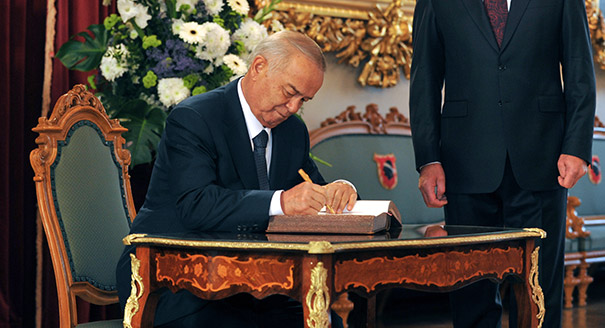After days of speculation about his health, Islam Karimov, the first and only president of independent Uzbekistan, was pronounced dead on September 2.
Karimov’s death has cast the country into uncertainty; analysts have predicted a surge of Islamic fundamentalism, ethnic and regional disputes, confrontation between political clans, and even civil war.
The president’s passing has, perhaps most importantly, touched off a succession crisis: because Karimov did not designate an heir, a political battle to assume the throne is under way in Tashkent. Three men stand out as potential successors: Prime Minister Shavkat Mirziyoyev, First Deputy Prime Minister and Finance Minister Rustam Azimov, and National Security Service (SNB) chief Rustam Inoyatov.
While Mirziyoyev and Azimov are public figures who seem to be ready to run for president (an election is supposed to be held within three months), Inoyatov may act more as a grey cardinal, manipulating Mirziyoyev—his close associate—rather than seeking elected office.
Perhaps the most likely candidate to move into the presidential palace is the fifty-nine-year-old Mirziyoyev, though he isn’t exactly popular in Uzbekistan: Karimov looked to Mirziyoyev to solve the most challenging issues facing the country, making him somewhat disliked among the population.
 Shavkat Mirziyoyev. Source: Vitaly Beloysov/TASSMirziyoyev is known for his hot temper. It is said that he routinely insults and hits his subordinates. According to reports from human rights activists, when he was governor of the Dzhizak region, Mirziyoyev beat a local college teacher to death for refusing to bring his students to work in cotton fields in the pouring rain.
Shavkat Mirziyoyev. Source: Vitaly Beloysov/TASSMirziyoyev is known for his hot temper. It is said that he routinely insults and hits his subordinates. According to reports from human rights activists, when he was governor of the Dzhizak region, Mirziyoyev beat a local college teacher to death for refusing to bring his students to work in cotton fields in the pouring rain.
But Karimov, who was also known to hit his subordinates, apparently liked Mirziyoyev’s management style, and kept him in office longer than any of his predecessors. In essence, he is a carbon copy of Karimov, though it is unclear whether he will be able to replicate the president’s resourcefulness and diplomatic flexibility.
Some media outlets call Mirziyoyev a “pro-Russian politician” because of his family connections, despite the fact that no one but the president is allowed to express their political preferences in Uzbekistan. It is true that the prime minister’s niece was married to Babur Usmanov—the nephew and heir apparent of the Russian billionaire and Uzbekistan native Alisher Usmanov. However, Babur was killed in a car accident in Tashkent several years ago, so whatever familial connection there was is gone now.
Mirziyoyev is said to be close to the entire Karimov family, as well as to Rustam Inoyatov. There are a great number of theories purporting to explain the alliance between the prime minister and the SNB head, including that Inoyatov planted Mirziyoyev in Karimov’s inner circle so that he would be able to influence the president.
Inoyatov has been at the helm of Uzbekistan’s security service for more than twenty years and controls all of Uzbekistan’s major military and security structures; Inoyatov has his own army that includes Uzbekistan’s most combat-ready detachments. What’s more, some reports suggest that Inoyatov’s people in the presidential administration kept a close eye on Karimov’s communications with the heads of regions and ministries.
Inoyatov has been in his position longer than any other official of the same rank; with the exception of Zelikhman Khaydarov, the head of Karimov’s presidential administration, he is the only Uzbek politician to have worked alongside Karimov in the 1990s.
Still, Inoyatov’s work gets little publicity. The first decent-quality photographs of him appeared in the media only in 2014, when the Chinese press published information about his visit there. No one is officially prohibited from taking Inoyatov’s picture; journalists simply don’t have access to SNB officials.
 Rustam Azimov. Source: Alexander Saverkin/TASSThe third potential candidate to replace Karimov is Rustam Azimov, who became finance minister in 1998 and whose knowledge of free market principles helped him become a fixture on Karimov’s team. To many in Uzbekistan and the émigré community, Azimov’s name is associated with liberalism: he has a master’s degree from Oxford, which probably makes him the most well-educated man in the government.
Rustam Azimov. Source: Alexander Saverkin/TASSThe third potential candidate to replace Karimov is Rustam Azimov, who became finance minister in 1998 and whose knowledge of free market principles helped him become a fixture on Karimov’s team. To many in Uzbekistan and the émigré community, Azimov’s name is associated with liberalism: he has a master’s degree from Oxford, which probably makes him the most well-educated man in the government.
That being said, he isn’t altogether different from other Uzbek leaders who ascended to power under Karimov; he just never directly persecuted political dissenters, like Inoyatov, or drove people to the cotton fields en masse, like Mirziyoyev.
The names of other potential presidential candidates have also surfaced, including Gulnara Karimova (Karimov’s daughter); Akbar Abdullayev (Karimov’s nephew); SNB General Shukhrat Gulyamov; and many other lesser-known figures who are no longer politically active. Uzbek businessman Gafur Rakhimov, whom U.S. authorities consider to be one of the main suppliers of Afghan heroin to Europe, has also been mentioned.
At the end of the day, however, Inoyatov, Mirziyoyev, and Azimov are the most plausible successors because they are responsible for the most important aspects of state policy: the economy, security, and domestic and foreign policy.
What matters most is these three men’s ability to agree on who will be the next president of Uzbekistan; a protracted power struggle could prove disastrous. One of them—perhaps, Azimov—may be eliminated. It’s also possible that, as in Turkmenistan, the president will be replaced by a second- or even third-tier government official.
In any case, the caution with which officials in Tashkent handled information about the president’s grave medical condition and death suggest that the struggle for power may be only just beginning.
